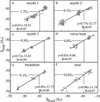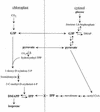Natural abundance carbon isotope composition of isoprene reflects incomplete coupling between isoprene synthesis and photosynthetic carbon flow
- PMID: 12692331
- PMCID: PMC166928
- DOI: 10.1104/pp.102.012294
Natural abundance carbon isotope composition of isoprene reflects incomplete coupling between isoprene synthesis and photosynthetic carbon flow
Abstract
Isoprene emission from leaves is dynamically coupled to photosynthesis through the use of primary and recent photosynthate in the chloroplast. However, natural abundance carbon isotope composition (delta(13)C) measurements in myrtle (Myrtus communis), buckthorn (Rhamnus alaternus), and velvet bean (Mucuna pruriens) showed that only 72% to 91% of the variations in the delta(13)C values of fixed carbon were reflected in the delta(13)C values of concurrently emitted isoprene. The results indicated that 9% to 28% carbon was contributed from alternative, slow turnover, carbon source(s). This contribution increased when photosynthesis was inhibited by CO(2)-free air. The observed variations in the delta(13)C of isoprene under ambient and CO(2)-free air were consistent with contributions to isoprene synthesis in the chloroplast from pyruvate associated with cytosolic Glc metabolism. Irrespective of alternative carbon source(s), isoprene was depleted in (13)C relative to mean photosynthetically fixed carbon by 4 per thousand to 11 per thousand. Variable (13)C discrimination, its increase by partially inhibiting isoprene synthesis with fosmidomicin, and the associated accumulation of pyruvate suggested that the main isotopic discrimination step was the deoxyxylulose-5-phosphate synthase reaction.
Figures




Similar articles
-
Contribution of different carbon sources to isoprene biosynthesis in poplar leaves.Plant Physiol. 2004 May;135(1):152-60. doi: 10.1104/pp.103.037374. Epub 2004 Apr 30. Plant Physiol. 2004. PMID: 15122010 Free PMC article.
-
On-line analysis of the (13)CO(2) labeling of leaf isoprene suggests multiple subcellular origins of isoprene precursors.Planta. 2002 Oct;215(6):894-905. doi: 10.1007/s00425-002-0825-2. Epub 2002 Jul 17. Planta. 2002. PMID: 12355149
-
Dynamic balancing of isoprene carbon sources reflects photosynthetic and photorespiratory responses to temperature stress.Plant Physiol. 2014 Dec;166(4):2051-64. doi: 10.1104/pp.114.247494. Epub 2014 Oct 15. Plant Physiol. 2014. PMID: 25318937 Free PMC article.
-
Isoprene synthesis by plants and animals.Endeavour. 1996;20(2):74-8. doi: 10.1016/0160-9327(96)10014-4. Endeavour. 1996. PMID: 8690002 Review.
-
The future of isoprene emission from leaves, canopies and landscapes.Plant Cell Environ. 2014 Aug;37(8):1727-40. doi: 10.1111/pce.12289. Epub 2014 Mar 6. Plant Cell Environ. 2014. PMID: 24471530 Review.
Cited by
-
Heat stress increases the use of cytosolic pyruvate for isoprene biosynthesis.J Exp Bot. 2019 Oct 24;70(20):5827-5838. doi: 10.1093/jxb/erz353. J Exp Bot. 2019. PMID: 31396620 Free PMC article.
-
Biosynthesis, accumulation and emission of carotenoids, alpha-tocopherol, plastoquinone, and isoprene in leaves under high photosynthetic irradiance.Photosynth Res. 2007 May;92(2):163-79. doi: 10.1007/s11120-007-9204-y. Epub 2007 Jul 17. Photosynth Res. 2007. PMID: 17634750 Review.
-
Contribution of different carbon sources to isoprene biosynthesis in poplar leaves.Plant Physiol. 2004 May;135(1):152-60. doi: 10.1104/pp.103.037374. Epub 2004 Apr 30. Plant Physiol. 2004. PMID: 15122010 Free PMC article.
-
Evidence that light, carbon dioxide, and oxygen dependencies of leaf isoprene emission are driven by energy status in hybrid aspen.Plant Physiol. 2009 Sep;151(1):448-60. doi: 10.1104/pp.109.141978. Epub 2009 Jul 8. Plant Physiol. 2009. PMID: 19587097 Free PMC article.
-
Isoprene emission from plants: why and how.Ann Bot. 2008 Jan;101(1):5-18. doi: 10.1093/aob/mcm240. Epub 2007 Oct 6. Ann Bot. 2008. PMID: 17921528 Free PMC article. Review.
References
-
- Bakwin PS, Tans PP, White JWC, Andres RJ. Determination of the isotopic (13C/12C) discrimination by terrestrial biology from a global network of observations. Global Biogeochem Cycles. 1998;12:555–562.
-
- Bowling DR, Tans PP, Monson RK. Partitioning net ecosystem carbon exchange with isotopic fluxes of CO2. Global Change Biol. 2001;7:127–145.
-
- Canvin DT. Photorespiration: comparison between C3 and C4 plants. In: Gibbs M, Latzko E, editors. Encyclopedia of Plant Physiology NS. 6: Photosynthesis II. Berlin: Springer-Verlag; 1979. pp. 368–396.
-
- Chameides WL, Lindsay RW, Richardson J, Kiang CS. The role of biogenic hydrocarbons in urban photochemical smog: Atlanta as a case study. Science. 1988;241:1473–1475. - PubMed
MeSH terms
Substances
LinkOut - more resources
Full Text Sources
Other Literature Sources

